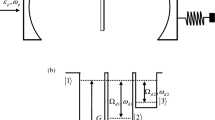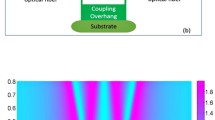Abstract
We theoretically analyze the phenomenon of Optomechanically Induced Transparency (OMIT) of a weak probe field in a hybrid optomechanical system, consisting of an optical cavity, a mechanical resonator and Quantum Dot molecules(QDs), in addition, in some parameter regimes, the probe transmission can exceed unity. Furthermore, the phase dispersion and group delay at the frequency of the probe field have been studied, we can control the fast light effect by tuning the driving field and tunneling coupling, attributed to quantum interference and Tunneling effect, it provides a flexible way to control optical response and propagation in such a hybrid optomechanical system.





Similar content being viewed by others

References
Vitali, D., Gigan, S., Ferreira, A., Böhm, H.R., Tombesi, P., Guerreiro, A., Vedral, V., Zeilinger, A., Aspelmeyer, M.: Optomechanical entanglement between a movable mirror and a cavity field. Phys. Rev. Lett. 98, 030405 (2007). https://doi.org/10.1103/PhysRevLett.98.030405
Kippenberg, T.J., Vahala, K.J.: Cavity optomechanics: Back-action at the mesoscale. Science 321(5893), 1172–1176 (2008). https://doi.org/10.1126/science.1156032
Gröblacher, S., Hammerer, K., Vanner, M.R., Aspelmeyer, M.: Observation of strong coupling between a micromechanical resonator and an optical cavity field. Nature. 460, 724 (2009). https://doi.org/10.1038/nature08171
Aspelmeyer, M., Kippenberg, T.J., Marquardt, F.: Cavity optomechanics. Rev. Mod. Phys. 86, 1391–1452 (2014). https://doi.org/10.1103/RevModPhys.86.1391
Chen, X., Liu, Y.-C., Peng, P., Zhi, Y., Xiao, Y.-F.: Cooling of macroscopic mechanical resonators in hybrid atom-optomechanical systems. Phys. Rev. A 92, 033841 (2015). https://doi.org/10.1103/PhysRevA.92.033841
Liu, Y.-C., Xiao, Y.-F., Luan, X., Wong, C.W.: Optomechanically-induced-transparency cooling of massive mechanical resonators to the quantum ground state. Phys. Rev. A 58, 1 (2015). https://doi.org/10.1007/s11433-014-5635-6
Agarwal, G.S., Huang, S.: Electromagnetically induced transparency in mechanical effects of light. Phys. Rev. A 81, 041803 (2010). https://doi.org/10.1103/PhysRevA.81.041803
Weis, S., Riviėre, R., Deléglise, S., Gavartin, E., Arcizet, O., Schliesser, A., Kippenberg, T.J.: Optomechanically induced transparency. Science 330(6010), 1520–1523 (2010). https://doi.org/10.1126/science.1195596
Safavi-Naeini, A.H., Alegre, T.P.M., Chan, J., Eichenfield, M., Winger, M., Lin, Q., Hill, J.T., Chang, D.E., Painter, O.: Electromagnetically induced transparency and slow light with optomechanics. Nature 472, 69 (2011). https://doi.org/10.1038/nature09933
Xiong, H., Si, L.-G., Zheng, A.-S., Yang, X., Wu, Y.: Higher-order sidebands in optomechanically induced transparency. Phys. Rev. A 86, 013815 (2012). https://doi.org/10.1103/PhysRevA.86.013815
Yan, X.-B.: Optomechanically induced transparency and gain. Phys. Rev. A 101, 043820 (2020). https://doi.org/10.1103/PhysRevA.101.043820
Xuereb, A., Barbieri, M., Paternostro, M.: Multipartite optomechanical entanglement from competing nonlinearities. Phys. Rev. A 86, 013809 (2012). https://doi.org/10.1103/PhysRevA.86.013809
Liao, Q., Xiao, X., Nie, W., Zhou, N.: Transparency and tunable slow-fast light in a hybrid cavity optomechanical system. Opt. Express 28 (4), 5288–5305 (2020). https://doi.org/10.1364/OE.382254
Liu, J.-H., Yu, Y.-F., Zhang, Z.-M.: Nonreciprocal transmission and fast-slow light effects in a cavity optomechanical system. Opt. Express 27(11), 15382–15390 (2019). https://doi.org/10.1364/OE.27.015382
Jiang, C., Cui, Y., Zhai, Z., Yu, H., Li, X., Chen, G.: Tunable slow and fast light in parity-time-symmetric optomechanical systems with phonon pump. Opt. Express 26(22), 28834–28847 (2018). https://doi.org/10.1364/OE.26.028834
Sarma, B., Sarma, A.K.: Controllable optical bistability in a hybrid optomechanical system. J. Opt. Soc. Am. B 33(7), 1335–1340 (2016). https://doi.org/10.1364/JOSAB.33.001335
Kazemi, S.H., Ghanbari, S., Mahmoudi, M.: Controllable optical bistability in a cavity optomechanical system with a bose-einstein condensate. Laser Physics 26(5), 055502 (2016). https://doi.org/10.1088/1054-660x/26/5/055502
Chang, Y., Shi, T., Liu, Y.-X., Sun, C.P., Nori, F.: Multistability of electromagnetically induced transparency in atom-assisted optomechanical cavities. Phys. Rev. A 83, 063826 (2011). https://doi.org/10.1103/PhysRevA.83.063826
Rabl, P.: Photon blockade effect in optomechanical systems. Phys. Rev. Lett. 107, 063601 (2011). https://doi.org/10.1103/PhysRevLett.107.063601
Ma, Y., Danilishin, S.L., Zhao, C., Miao, H., Korth, W.Z., Chen, Y., Ward, R.L., Blair, D.G.: Narrowing the filter-cavity bandwidth in gravitational-wave detectors via optomechanical interaction. Phys. Rev. Lett. 113, 151102 (2014). https://doi.org/10.1103/PhysRevLett.113.151102
Großardt, A., Bateman, J., Ulbricht, H., Bassi, A.: Optomechanical test of the schrödinger-newton equation. Phys. Rev. D 93, 096003 (2016). https://doi.org/10.1103/PhysRevD.93.096003
Ranjit, G., Cunningham, M., Casey, K., Geraci, A.A.: Zeptonewton force sensing with nanospheres in an optical lattice. Phys. Rev. A 93, 053801 (2016). https://doi.org/10.1103/PhysRevA.93.053801
Arcizet, O., Cohadon, P.-F., Briant, T., Pinard, M., Heidmann, A., Mackowski, J.-M., Michel, C., Pinard, L., Français, O., Rousseau, L.: High-sensitivity optical monitoring of a micromechanical resonator with a quantum-limited optomechanical sensor. Phys. Rev. Lett. 97, 133601 (2006). https://doi.org/10.1103/PhysRevLett.97.133601
Vučković, J., Yamamoto, Y.: Photonic crystal microcavities for cavity quantum electrodynamics with a single quantum dot. Appl. Phys. Lett 82, 2374 (2003). https://doi.org/10.1063/1.1567824
Jelezko, F., Wrachtrup, J.: Single defect centres in diamond: A review. Physica Status Solidi (a) 203(13), 3207–3225 (2006). https://doi.org/10.1002/pssa.200671403
Michler, P.: Single semiconductor quantum dots.Springer (2009)
Englund, D., Fattal, D., Waks, E., Solomon, G., Zhang, B., Nakaoka, T., Arakawa, Y., Yamamoto, Y., Vučković, J.: Controlling the spontaneous emission rate of single quantum dots in a two-dimensional photonic crystal. Phys. Rev. Lett. 95, 013904 (2005). https://doi.org/10.1103/PhysRevLett.95.013904
Brossard, F.S.F., Xu, X.L., Williams, D.A., Hadjipanayi, M., Hugues, M., Hopkinson, M., Wang, X., Taylor, R.A.: Strongly coupled single quantum dot in a photonic crystal waveguide cavity. Appl. Phys. Lett. 97(11), 111101 (2010). https://doi.org/10.1063/1.3487937
Andreas, R., et al.: Strongly correlated photons on a chip. Nature Photonics 6, 93–96 (2011). https://doi.org/10.1038/nphoton.2011.321
Peter, L., et al.: Controlling the dynamics of spontaneous emission from quantum dots by photonic crystals. Nat. Photonics 430, 654–657 (2004). https://doi.org/10.1038/nature02772
Bhattacherjee, A.B., Hasan, M.S.: Controllable optical bistability and fano line shape in a hybrid optomechanical system assisted by kerr medium: possibility of all optical switching. J. Mod. Opt. 65(14), 1688–1697 (2018). https://doi.org/10.1080/09500340.2018.1455917
Bhatt, V., Barbhuiya, S.A., Jha, P.K., Bhattacherjee, A.B.: Controllable bistable optical switch and normal mode splitting in hybrid optomechanical semiconductor microcavity containing single quantum dot driven by amplitude modulated field. Journal of Physics B: Atomic, Molecular and Optical Physics 53(15), 155402 (2020). https://doi.org/10.1088/1361-6455/ab91e1
Degen, C.L., Reinhard, F., Cappellaro, P.: Quantum sensing. Rev. Mod. Phys. 89, 035002 (2017). https://doi.org/10.1103/RevModPhys.89.035002
She, Y., Zheng, X., Wang, D., Zhang, W.: Controllable double tunneling induced transparency and solitons formation in a quantum dot molecule. Opt. Express 21(14), 17392–17403 (2013). https://doi.org/10.1364/OE.21.017392
Gardiner, C.W., Collett, M.J.: Input and output in damped quantum systems: Quantum stochastic differential equations and the master equation. Phys. Rev. A 31, 3761–3774 (1985). https://doi.org/10.1103/PhysRevA.31.3761
Clerk, A.A., Devoret, M.H., Girvin, S.M., Marquardt, F., Schoelkopf, R.J.: Introduction to quantum noise, measurement, and amplification. Rev. Mod. Phys. 82, 1155–1208 (2010). https://doi.org/10.1103/RevModPhys.82.1155
He, Q., Badshah, F., Din, R.U., Zhang, H., Hu, Y., Ge, G.-Q.: Optomechanically induced transparency and the long-lived slow light in a nonlinear system. J. Opt. Soc. Am. B 35(7), 1649–1657 (2018). https://doi.org/10.1364/JOSAB.35.001649
Al-Nashy, B., Amin, S.M.M., Al-Khursan, A.H.: Kerr effect in y-configuration double-quantum-dot system. J. Opt. Soc. Am. B 31(8), 1991–1996 (2014). https://doi.org/10.1364/JOSAB.31.001991
Fleischhauer, M., Imamoglu, A., Marangos, J.P.: Electromagnetically induced transparency: Optics in coherent media. Rev. Mod. Phys. 77, 633–673 (2005). https://doi.org/10.1103/RevModPhys.77.633
Wu, Y., Yang, X.: Electromagnetically induced transparency in v-, Λ-, and cascade-type schemes beyond steady-state analysis. Phys. Rev. A 71, 053806 (2005). https://doi.org/10.1103/PhysRevA.71.053806
Si, L.-G., Xiong, H., Zubairy, M.S., Wu, Y.: Optomechanically induced opacity and amplification in a quadratically coupled optomechanical system. Phys. Rev. A 95, 033803 (2017). https://doi.org/10.1103/PhysRevA.95.033803
Restrepo, J., Ciuti, C., Favero, I.: Single-polariton optomechanics. Phys. Rev. Lett. 112, 013601 (2014). https://doi.org/10.1103/PhysRevLett.112.013601
Restrepo, J., Favero, I., Ciuti, C.: Fully coupled hybrid cavity optomechanics: Quantum interferences and correlations. Phys. Rev. A 95, 023832 (2017). https://doi.org/10.1103/PhysRevA.95.023832
Wang, H., Gu, X., Liu, Y.-X., Miranowicz, A., Nori, F.: Optomechanical analog of two-color electromagnetically induced transparency: Photon transmission through an optomechanical device with a two-level system. Phys. Rev. A 90, 023817 (2014). https://doi.org/10.1103/PhysRevA.90.023817
Borges, H.S., Sanz, L., Villas-Bôas, J.M., Diniz Neto, O.O., Alcalde, A.M.: Tunneling induced transparency and slow light in quantum dot molecules. Phys. Rev. B 85, 115425 (2012). https://doi.org/10.1103/PhysRevB.85.115425
Jiang, C., Cui, Y., Zhai, Z., Yu, H., Li, X., Chen, G.: Phase-controlled amplification and slow light in a hybrid optomechanical system. Opt. Express 27(21), 30473–30485 (2019). https://doi.org/10.1364/OE.27.030473
Akram, M.J., Khan, M.M., Saif, F.: Tunable fast and slow light in a hybrid optomechanical system. Phys. Rev. A 92, 023846 (2015). https://doi.org/10.1103/PhysRevA.92.023846
Yan, X.-B.: Optomechanically induced ultraslow and ultrafast light. Physica E: Low-dimensional Systems and Nanostructures 131, 114759 (2021). https://doi.org/10.1016/j.physe.2021.114759
Borges, H.S., Alcalde, A.M., Ulloa, S.E.: Exchange interaction and tunneling-induced transparency in coupled quantum dots. Phys. Rev. B 90, 205311 (2014). https://doi.org/10.1103/PhysRevB.90.205311
O’Brien, J.L., Furusawa, A., Vučković, J.: Photonic quantum technologies. Nat. Photonics 3, 687 (2009). https://doi.org/10.1038/nphoton.2009.229
Acknowledgments
We submit our thanks to Yaotai Kang, Yukuai Liu and Bingwen Yang for valuable suggestions in our manuscript. We also acknowledge National Natural Science Foundation of China under Grant No. 11704287, Key Research Platform and Program in Universities of Department of Education of Guangdong Province (No.2020GCZX003) , State Key Laboratory of Advanced Materials and Electronic Components (No.FHR-JS-202011007) for financial support.
Author information
Authors and Affiliations
Corresponding author
Additional information
Publisher’s Note
Springer Nature remains neutral with regard to jurisdictional claims in published maps and institutional affiliations.
Appendix A:: Calculation of c +
Appendix A:: Calculation of c +
When substituting the exponential form ansatz into (15), we get eight equations as follows:
One of its solutions is
where \(O_{1}=\kappa -i{\Delta }_{1}-i\delta -i g_{1} (b_{s}+b_{s}^{*})\), \(O_{2}=({\Gamma }_{1}-i\delta )({\Gamma }_{2}-i\delta )+{T_{e}^{2}}\), O3 = γm + iωm − iδ, \(O_{4}=\kappa +i{\Delta }_{1}-i\delta +i g_{1} (b_{s}+b_{s}^{*})\), \(M_{1}=\frac {ig_{1}c_{s}^{*}}{O_{1}O_{3}{g_{2}^{2}} \lvert {c_{s}}\rvert ^{2}}\big [O_{1}O_{3}+{g_{1}^{2}} \lvert {c_{s}}\rvert ^{2} \big ]\varepsilon _{p}\), \(M_{2}=\frac {ic_{s}^{*}O_{1}O_{2}+i{g_{2}^{2}} c_{s}({\Gamma }_{2}-i\delta )}{g_{1} \lvert {c_{s}}\rvert ^{2} O_{2}}+\frac {2iM_{1}}{\varepsilon _{p}}\big [{\Delta }_{1}+g_{1}(b_{s}+b_{s}^{*})\big ]\) and \(M_{3}=O_{1}O_{2}O_{3}O_{4}+i g_{1} c_{s} M_{2} O_{1}O_{2}O_{3}+2i{g_{1}^{2}} \lvert {c_{s}}\rvert ^{2} O_{2}\big [{\Delta }_{1}+g_{1}(b_{s}+b_{s}^{*})\big ]+{g_{2}^{2}} O_{1}O_{3}({\Gamma }_{2}-i\delta )\).
Rights and permissions
About this article
Cite this article
Li, XX., Li, JY., Cheng, XX. et al. Optical Response with Tunneling Coupling in a Hybrid Optomechanical System. Int J Theor Phys 61, 163 (2022). https://doi.org/10.1007/s10773-022-05151-5
Received:
Accepted:
Published:
DOI: https://doi.org/10.1007/s10773-022-05151-5



